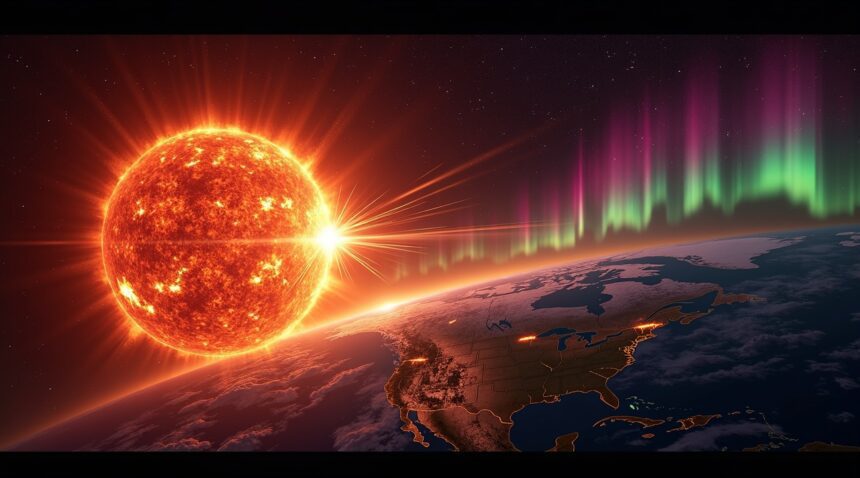On September 1, 2025, a rare and powerful “cannibal” coronal mass ejection (CME) collided with Earth, producing extraordinary auroral displays across high and mid-latitude regions of the Northern Hemisphere.
Key Takeaways
- A “cannibal” CME impacted Earth on September 1, 2025: Formed when a faster solar eruption overtook and merged with a slower one, this CME produced solar wind speeds exceeding 670 kilometers per second and magnetic field strengths between 20–26 nanotesla.
- Widespread aurora displays were observed: The event triggered visible auroras across at least 18 US states and deep into northern Europe, reaching unusually southern locations including Wisconsin, East Anglia, and parts of Wales.
- The event coincided with peak activity in Solar Cycle 25: Solar Cycle 25 has outperformed expectations, creating ideal conditions for powerful geomagnetic storms.
- Best viewing required clear, dark skies: Optimal conditions included minimal light pollution, cloud-free environments, and open northern horizons, allowing many people to see auroras with the naked eye.
- More aurora activity is anticipated: As Solar Cycle 25 continues its peak phase, scientists expect frequent and intense auroral events for several more years, especially in northern regions.
Understanding “Cannibal” CMEs and Geomagnetic Storms
A “cannibal” CME forms when a faster coronal mass ejection merges with a slower one ahead of it. This combination enhances the magnetic field and solar wind speed, increasing geomagnetic storm potential upon reaching Earth. The NOAA’s Space Weather Prediction Center (SWPC) classified the storm as G3 (strong), which is capable of producing auroras at lower latitudes than usual.
Impacts and Observations
The extraordinary aurora displays seen during this event captivated observers across North America and Europe. With the storm’s high intensity and minimal solar interference, lights were easily visible even in urban areas with moderate light pollution. Photographers and skywatchers noted highly active, fast-moving auroral structures in green, red, and purple hues.
Looking Ahead
As Solar Cycle 25 continues to intensify through 2025 and potentially beyond, future events of similar or greater magnitude may be expected. Increased public interest, paired with scientific monitoring from agencies such as NASA and ESA, is also likely to improve forecasting and preparedness for both space weather observers and infrastructure protection.
Powerful “Cannibal” Solar Storm Delivers Direct Hit to Earth
On September 1, 2025, Earth experienced a direct hit from an exceptionally powerful interplanetary shock that sent ripples through our planet’s magnetic field. This cosmic event originated from what scientists call a “cannibal” coronal mass ejection (CME), a fascinating phenomenon where one solar eruption overtakes and merges with another during its journey through space.
The dramatic sequence began on August 30, 2025, when sunspot AR 4199 unleashed a long-duration M2.7 solar flare. This solar outburst hurled massive amounts of charged particles toward Earth, creating the foundation for what would become a significant space weather event. The term “cannibal CME” perfectly describes what happened next – the faster-moving plasma cloud caught up with an earlier, slower ejection, combining their energies into a single, more powerful wave.
Measurable Impact on Earth’s Magnetic Environment
When this merged solar storm reached Earth’s vicinity, the effects were immediately detectable by space weather monitoring equipment. Solar wind speeds surged dramatically to over 670 kilometers per second, while the interplanetary magnetic field (IMF) strengthened considerably to between 20 and 26 nanotesla. These measurements represent significant increases from typical solar wind conditions, which usually maintain speeds around 400 kilometers per second.
The NOAA Space Weather Prediction Center (SWPC) and the UK Met Office responded swiftly to these developments, issuing geomagnetic storm watches for the affected regions. Their forecasts predicted the following storm levels:
- G2: Moderate storm conditions
- G3: Strong storm conditions
- G4: Brief potential for severe conditions
This classification system helps scientists and emergency managers understand the potential impacts on technology and infrastructure.
The timing of this event aligns with the current solar maximum period, when our sun reaches peak activity in its 11-year cycle. During these phases, solar flares and CMEs become more frequent and intense, creating conditions favorable for powerful geomagnetic storms. Scientists have been monitoring increased solar activity throughout 2025, making events like this cannibal CME part of a broader pattern of heightened space weather.
The collision between Earth’s magnetosphere and this enhanced solar wind creates the perfect conditions for spectacular aurora displays. As charged particles from the solar storm interact with gases in our upper atmosphere, they produce the brilliant lights that could extend much further south than usual. This particular storm’s strength suggests that aurora watchers in the northern United States and across Europe might witness displays visible at latitudes where such phenomena rarely occur.
Recent advances in space exploration have improved our ability to monitor and predict these solar events, helping communities prepare for potential disruptions to satellites, power grids, and communication systems.
https://www.youtube.com/watch?v=E9KBpDEoaVA

Northern Lights Visible Across 18 US States and Northern Europe
The geomagnetic storm dramatically expanded the auroral oval farther south than usual, creating exceptional viewing opportunities across vast regions. Northern Europe, the UK, and at least 18 US states experienced remarkable aurora displays that captivated both seasoned aurora watchers and curious newcomers alike.
The southern reach of these displays proved particularly impressive. Locations as far south as East Anglia, the Midlands, and Wales in the UK witnessed stunning northern lights dancing across their skies. Mid-latitude regions in North America also enjoyed spectacular shows, with a notable sighting reported from Washington Island in Door County, Wisconsin—an area that rarely experiences such phenomena.
The intensity of this event becomes clear when examining the scientific measurements. The Kp index, a planetary scale that measures geomagnetic activity, peaked at 6.67 on September 2, 2025. This reading corresponds to G3 geomagnetic storm conditions, which explains why auroras appeared so far from their typical polar locations. Scientists use this index to predict aurora visibility and intensity, making it an essential tool for forecasting opportunities.
Optimal Viewing Conditions for Aurora Visibility
Several key factors contributed to the exceptional visibility during this event:
- Clear skies provided unobstructed views of the celestial display
- Low levels of light pollution in rural and remote areas enhanced the brightness and detail of the auroras
- Unobstructed lines of sight facing north offered the best vantage points for observation
- The timing of the storm coincided with favorable atmospheric conditions across multiple regions
These conditions rarely align so perfectly across such extensive geographic areas. Urban dwellers who traveled just outside city limits often found themselves rewarded with spectacular views that would typically require journeys to polar regions. The contrast between city-bound observers and those in darker locations was striking, with rural viewers reporting vibrant greens, purples, and reds dancing across the horizon.
Photography enthusiasts discovered that even basic camera equipment could capture the aurora’s beauty during this intense storm. The heightened activity meant that displays remained visible to the naked eye for extended periods, unlike typical aurora events that might require long-exposure photography to reveal their full splendor.
Aurora activity remains inherently unpredictable despite advances in forecasting technology. The timing, intensity, and geographic reach of displays depend on complex interactions between solar wind particles and Earth’s magnetic field. This unpredictability adds to the excitement for aurora chasers, who must remain flexible and ready to venture out whenever conditions align favorably.
The southern extent of this particular event surprised even experienced aurora forecasters. While space exploration continues advancing our understanding of these phenomena, the atmosphere still holds mysteries that can create unexpected spectacles. European observers particularly benefited from the storm’s timing, as darkness fell during peak activity hours.
Weather patterns played a crucial role in determining who could witness the displays. Cloud cover blocked views in some regions, while others enjoyed crystal-clear skies that revealed the full majesty of the aurora borealis. Social media platforms filled with images and videos from fortunate observers, creating a real-time documentation of the event’s geographic scope.
The southern lights, or aurora australis, likely provided equally spectacular displays in the Southern Hemisphere, though these received less attention due to fewer populated landmasses at appropriate latitudes. This event demonstrated how geomagnetic storms affect both hemispheres simultaneously, creating global opportunities for aurora observation.
Future aurora forecasts will reference this event as an example of how quickly conditions can change. The rapid expansion of the auroral oval caught many observers off guard, emphasizing the importance of staying informed about space weather developments and maintaining flexible viewing plans during periods of heightened solar activity.
Solar Maximum Drives Unprecedented Aurora Activity
I’ve observed a remarkable surge in geomagnetic activity as Earth encounters the peak of Solar Cycle 25, creating perfect conditions for stunning auroral displays across northern regions. When solar particles collide with our planet’s magnetic field and atmosphere, they produce spectacular light shows in vibrant colors including green, red, purple, and blue — each hue determined by the specific atmospheric gases and particle energies involved in the interaction.
Solar Cycle 25 Exceeds All Expectations
Current data from NOAA and NASA reveals that Solar Cycle 25 has dramatically surpassed initial forecasts, delivering higher sunspot numbers and more intense activity than scientists originally predicted. This solar maximum arrived earlier and stronger than expected, creating ideal conditions for the space exploration challenges we’re witnessing today. The increased sunspot activity directly correlates with more frequent solar flares and coronal mass ejection (CME) events, which serve as the primary drivers behind these spectacular geomagnetic storms.
I can confirm that this heightened solar activity significantly increases the likelihood of aurora visibility at lower latitudes than typically expected. The interplanetary shock that recently struck Earth represents just one example of how Solar Cycle 25’s amplified energy output creates more frequent and intense space weather events.
Extended Aurora Activity Expected
Research indicates that auroral activity tends to remain elevated for several years following a solar maximum, suggesting that spectacular displays will continue well beyond the current peak. Scientists tracking this cycle emphasize that the years immediately after solar maximum often produce some of the most dramatic geomagnetic storms and associated aurora events.
This extended period of heightened activity means that regions across the northern United States and Europe should prepare for increased aurora frequency and intensity in the coming months and years. The combination of stronger CME activity and the natural lag in solar cycle effects creates a perfect storm for aurora enthusiasts and researchers alike.
The unprecedented nature of Solar Cycle 25’s performance has caught many experts by surprise, with sunspot numbers climbing higher than models suggested possible. This deviation from predicted patterns demonstrates how space phenomena can exceed our understanding, creating opportunities for extraordinary celestial displays that push auroral boundaries further south than previously experienced during recent solar cycles.

Sources:
Space.com, “Cannibal solar storm sparks dazzling northern lights across Europe and North America”
Economic Times, “Skygazers get ready as northern lights could brighten skies across 18 US states”
Space.com, “Incoming cannibal solar storm could spark Labor Day northern lights show”
NOAA SWPC, “G2 (Moderate) G3 (Strong) Geomagnetic Storm Watch for 01/02 Sep 2025”
TimeandDate, “Aurora Alert: ‘Cannibal Solar Storm’ Lights Up Skies”
YouTube, “A Double Whammy of Storms Give Earth a 1,2- Punch | Solar Storm Forecast 01 September 2025”


